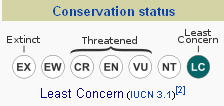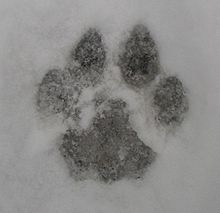Cougar (Puma concolor)
The cougar is the largest wild cat in North America. The coat is typically tawny, but ranges to silvery-grey or reddish, with lighter patches on the under body including the jaws, chin, and throat. Infants are spotted and born with blue eyes and rings on their tails. Young cougars have spots but adults do not. Cougars have powerful limbs and can leap as high as 15 feet and as far as 40 feet.
Size
- Height: 2-2.3 ft at shoulders
- Length: 3.5-5.5 ft (2-2.5 ft, tail length)
- Weight: 110-180 lbs for males; females weigh slightly less
Lifespan
- About 12 years in the wild
- Up to 25 years in captivity
Reproduction
- Mating Season: Commonly from December-March, but can happen at any time during the year
- Gestation: 82-96 days
- Litter Size: 2-4 kittens
- Kitten Rearing: Mother cougars raise their young alone. The kittens nurse for two months, and then start to travel with their mother at which time she teaches them to hunt. They will remain with their mother for 1 1/2 – 2 years. Males that enter another male’s territory have been known to kill the kittens so that females will be receptive to mate.
Range
Diet
Behavior/Habitat
Cougars are solitary animals. They are very territorial and actively avoid other cats except during courtship. Their ranges can vary in size from 10 square miles to around 370 square miles; females tend to have smaller ranges than males. Cougars are active hunters and may travel long distances in search of food. They hunt alone and attack from behind, breaking the neck of their prey by biting it at the base of the skull. After killing their prey, they will bury it and leave it, coming back to feed on it when hungry. Cougars are highly adaptive and, therefore, live in a wide variety of habitats.


Population/Status
There are an estimated 30,000 cougars in the western U.S. One cougar subspecies, the Florida panther, is critically endangered with a population of less than 100 individuals.
Florida Panther (Puma concolor coryi)
IUCN: critically endangered CITES: Appendix I
Eastern Puma (Puma concolor couguar)
IUCN: endangered CITES: Appendix I
Costa Rican Puma (Puma concolor costaricensis)
IUCN: endangered CITES: Appendix I
The remaining subspecies
IUCN: near threatened CITES: Appendix I
Threats
Aside from humans, no species preys upon mature cougars in the wild They have long been persecuted and hunted as a threat to livestock. Current threats also include habitat loss and poaching.
Interesting Facts
- Cougars are the fourth largest cats.
- Cougars go by many different names, such as mountain lion, catamount, painter, panther, ghost cat and puma.
- Cougars are the largest of the “small cats,” and so the largest cat that can purr while inhaling and exhaling. They cannot roar.
- Cougars are opportunistic hunters in that they will hunt day or night, whenever food is available.
- The chances of being attack by a cougar are slim as they generally tend to avoid humans.
- There are over 20 subspecies of the cougar, determined by size, coloring and location.
- The Inca city of Cusco is reported to have been designed in the shape of a cougar, and the animal also gave its name to both Inca regions and people.
- An adult pawprint is approximately 4 inches long.
The world does not pay for what a person knows. But it pays for what a person does with what he knows.
~Laurence Lee

Primary Sources:
Defenders of Wildlife and Wikipedia






